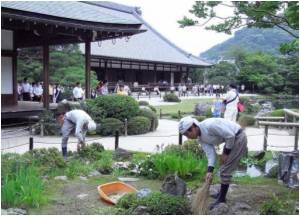A tiny plant called Arabidopsis thaliana just helped scientists unearth new clues about the daily cycles of many organisms, including humans.

Some human cells, including cancer cells, divide with a 24-hour rhythm. One of the main human circadian rhythm genes, cryptochrome, has been associated with diabetes and depression. Both of these discoveries grew from work with plants.
"We don't have stems and we don't flower, but our body parts, like those of plants, are controlled by circadian clocks," says NIH geneticist Laurie Tompkins. "Clocks operate more or less the same way in all organisms, but some aspects of clock function are easier to study in plants."
The new work, released this week in the early online publication of Nature, investigated why Arabidopsis does its major stem-growing in the dark—a pattern common to most plants. Biologist Steve Kay and colleagues at the University of California, San Diego, report that a specific trio of proteins regulates the rhythm in Arabidopsis stems.
The group of proteins, called the evening complex, interacts in the early evening to silence two genes that usually promote plant growth. When the evening complex's activity trails off a few hours before dawn, proteins release the brakes on growth and plants enter their nightly phase of rapid stem elongation.
When Kay's team mutated the three genes that code for the evening complex, they noticed that this made the Arabidopsis biological clock run out of sync—stems grew unusually long and flowered early.
Advertisement
"Our understanding of human health and the role of clocks in health and disease can greatly benefit from studying how clocks work in plants," he adds.
Advertisement
From Crops to Cures
Scientists like Kay are interested in answering basic biological questions, but others who work with plants have their eyes on future disease therapies.
Plant-based molecules, for instance, are being used to target reservoirs of HIV that hide out in their hosts. At the University of California, Berkeley, chemist Jay Keasling is looking for simple ways to get microbes to produce greater quantities of these plant-based molecules at lower cost.
How plants like Arabidopsis suppress harmful genes may also help improve HIV therapies. A team of biologists led by Craig Pikaard at Washington University in St. Louis is investigating RNA polymerases, chemicals important in determining which genes get switched on, to learn how plants silence harmful virus-derived genes. Similar silencing pathways could be harnessed for HIV therapies.
More generally, scientists are looking toward plants as a medicinal source. Chemist Sarah O'Connor at MIT is genetically engineering periwinkle plants, the natural source of the anticancer drug vinblastine, to produce variations of the drug with halogens attached. Halogens make some medicines last longer in the body, meaning that probing periwinkle's capabilities could make cancer treatments more effective.
Source-Eurekalert









